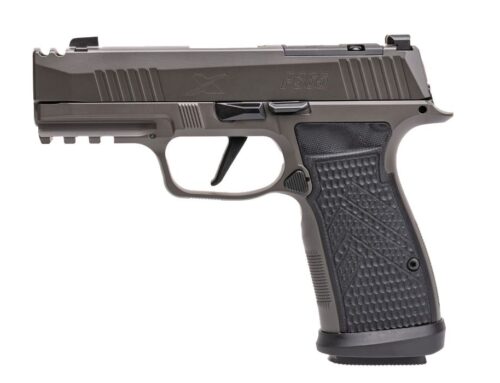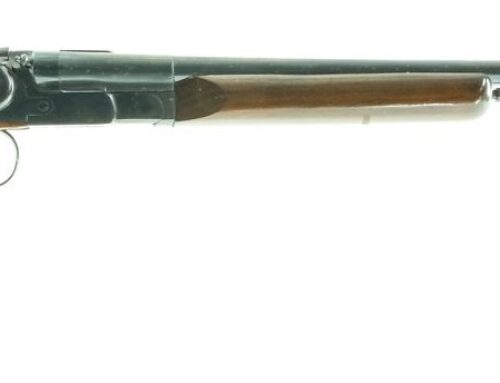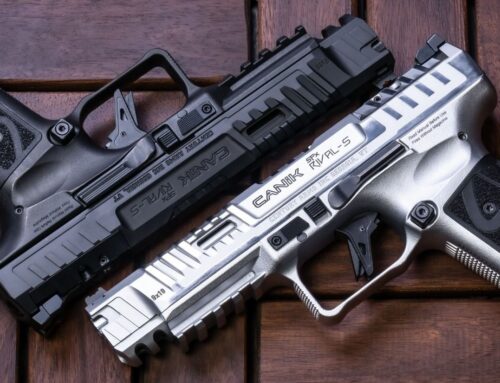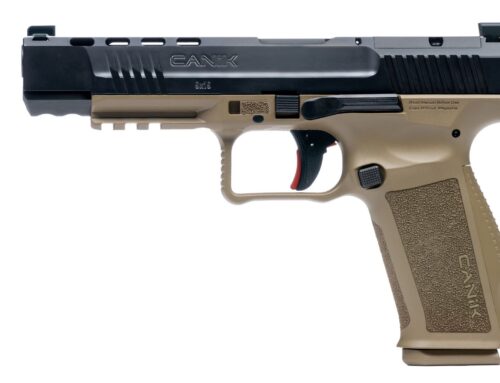It turns out there is quite a lot more to learn about .308 caliber AR rifles compared to their five millimeter siblings. Finding somewhere to start can be a little daunting and has led me on an adventure into the wonderful world of big bore Armalites.
These bigger framed ARs are harder to find, are often quite expensive, and in today’s market they are frequently out of stock. Reviews were watched and read. Websites were searched. What I ultimately landed on was PSA as they seemed to tick all of the boxes. Affordably priced. Well liked. Plus the real biggie, they were in stock. In fact, PSA had quite a few options in stock.
The model being reviewed is a Gen 3 with a stainless 18″ barrel and a Nickel Boron two-stage trigger which seemed to be highly appreciated by reviewers. One detail about the PSA rifles which I legitimately liked is that they are wholly plain Jane rifles. You can easily spend three times as much on something that’s already highly customized and fully tricked out but sometimes they come with some features or upgrades which you may not like and they can get quite expensive. With the PSA rifles you get a solid starting point with which to build off of and personalize. It’s not trying to be anything fancy, it’s just a .308 workhorse.
One way in which AR-15s are so great is that you can customize every last pin and spring on them. Curiously, despite the AR-10 being the first out of the two to have been manufactured back in the day there is no industry standard on thirty caliber ARs! Technically the majority of what we all call AR-10s isn’t correct at all. While the 10s do exist they make up a much smaller corner of the market and use their own less common magazines.
The first part of my re-education is learning that the majority of thirty caliber ARs are properly called LR-308 rifles, a term which I believe originated from DPMS. Because there is no standard every company has been free to design such platforms however they wanted and that has led to a whole bunch of proprietary parts. With these rifles one size does not fit all.
Adding to this confusion, an excellent comparison guide from monstrumtactical.com mentions that among the DPMS rifles there are three different profiles for the upper receiver alone, albeit one of them being much less common.
Oh, and then DPMS came out with a G2 pattern rifle which is even more different. The DPMS G1 and G2 rifles are also completely different from the PSA G1, G2, and G3 platforms.
Thirty caliber AR barrel nuts are also worth noting for incompatibility. An LR-308 is different from an AR-10 which is different from a Gen 2 DPMS which are all different from an AR-15. Good luck trying to swap out that handguard!
DPMS may have disappeared a long time ago but from what I’ve been led to believe Palmetto State Armory picked up the Gen 1 DPMS pattern and that is what they are currently manufacturing. PSA also has Gen 1, Gen 2, and Gen 3 rifles but as far as I’ve been able to determine these are dimensionally the same with the major differences being cosmetics. Mixing and matching across the Palmetto State line should be possible but the receiver lines won’t match up quite right. In theory a Gen 1 DPMS could also swap but I cannot say with certainty. However, I can say that a Gen 2 DPMS is completely different and shares more in common with an AR-15 than an LR-308.
Now then! The Gen 3 PSA PA-10 is (I think!) a Generation 1 DPMS LR-308 pattern rifle with a “high profile” upper receiver which feeds from the much more common SR-25 pattern magazines. Well known options include Magpul “LR/SR” marked magazines, Lancer L7 mags, and Hexmag LR-308/SR-25 mags. Most metal magazines such as DPMS marked ones should also work as chances are they are the same pattern. Both a stubby DPMS mag and an unmarked 20 rounder engage the bolt catch.
One consideration with any AR is the bolt handle. The military style one is, frankly, awful and there is zero reason why anyone should have to settle for such a design. With a .308 pattern AR you may also want to consider that there’s a lot more mass and likely a stiffer spring which typically has a longer length of travel compared to any 5.56 rifle. Having a charging handle which you can get a proper grip on can make all of the difference.
Unfortunately, aftermarket options for charging handles are exceedingly slim these days with most everything out of stock but I can confirm that a POF USA handle drops right in. The fit may be a little snug but it immediately improves the bolt pull. The “Tomahawk” model has some pretty massive latches to hold onto but I found on a LR-308 they felt just right.
Fortunately there is some parts compatibility with AR-15s including safeties, stocks, buffer tubes, and grips. I believe mag releases, hammers and triggers are as well. Bolt catches, dust covers and takedown pins are not compatible but hammer and trigger pins are. I do not know what kind of buffer spring PSA uses on their rifles but I suspect that any .308 rated spring will do the trick. Muzzle devices are standard .308 spec.
The rear grip which comes standard on these rifles has the standard thirty degree cant and is made of overmold rubber much like a Hogue, however the PSA grips are incredibly thin and didn’t feel like they were a great fit on the PA-10. Since the grips are AR-15 compatible they can be swapped out but there are some points which are worth keeping in mind. The PSA rifles have integrated trigger guards but they aren’t quite flush with the bottom of any grip which I have seen, including the grip from PSA. There may also be a gap on grips which have an extended palm swell or beavertail but they should still fit. Magpul’s K2 grip and a little sanding makes for a pretty good combo.
Also worth mentioning is that the spring and detent for the rear takedown pin are held in by the grip rather than the stock end plate as with an AR-15. The PSA grip didn’t have any reinforcement here so the spring was digging into the rubber coating and caused minor deformation in the material. Some aftermarket grips may lack the necessary support in this area. Be very careful not to kink the spring when installing a new grip.
The 15″ aluminum handguard on this model features M-Lok slots at three, six and nine o’clock with an interrupted top rail and a QD mount near the back on both sides. It has a nice look with bunches of wide holes to save weight and help with airflow, however I feel like these gaps are a little TOO large for a bare handed grip. It feels like some of my fingertips might slip through these vents or maybe the corner of a nail might get caught during the expectedly sharp recoil. Some good M-Lok covers or a vertical foregrip may be a consideration for some.
This model also comes standard with a five position adjustable gas block but I do have some complaints about the setup. From PSA it’s dialed in to have the best reliability with all types of ammo so it’s really there for those who wish to fine-tune their guns or run suppressed. The first problem is that there are no instructions on how to adjust it. PSA has both 3 and a 5 position adjustable blocks and I couldn’t tell you which one might be newer or better.
The second problem is that they have this gas block on a mid length tube so they send the world’s longest Allen wrench with the rifle so you can adjust the gas settings through the front of the handguard, not through one of the large side vents. I would have much preferred either a shorter handguard option to save some more weight or a rifle length gas tube for easier reach and a somewhat softer recoil. This combination seems wacky to me.
The heart of the rifle is a Toolcraft bolt carrier group with an extra power extractor spring and staked gas key. PSA does not mention what the surface finish is but it feels like Melonite to me. The bolt itself is marked .308 and “MPI’ for magnetic particle inspected.
The barrel is 416R stainless steel with 1/10” twist and is marked both “Palmetto” and, of particular interest to me, .308. A surprising number of “.308″ rifles are in fact only rated for 7.62×51 NATO which is a lower power cartridge. Running actual .308 ammo through a 7.62 gun runs the risk of malfunctions, or worse. The PA-10 will feed all of the above, a major plus for me.
Another positive is that the upper and lower receivers and the buffer tube are all 7075 T6 aluminum. The handguard’s material is not listed but it is anti-slip and anti-rotation. The receivers are hardcoat anodized and the lower has M4 feed ramps.
Shooting an LR-308 is quite the experience. They look and feel like an AR-15 but man do they have bite! I got a little flinchy until I could retrain my brain for this gun but when I do my part I can land three shots in the same hole at a limited 25 yards. Other reviewers online have been quite thrilled with how it holds up at proper distances with some claiming that accuracy improves after the barrel gets worn in. As the reviewers seemed to agree the two stage trigger is quite nice with only a hint of second stage movement before breaking.
Overall I find the Palmetto State Armory PA-10 to be a good rifle but not a great rifle. PSA has been knocking it out of the park for firearm availability but as I had suspected their quality control has taken a step back. This rifle originally came with some superficial scratches and gouges in the barrel, a charging handle where the roll pin for the catch wasn’t correctly installed and some wobble (not rotation) of the trigger pin.
The good news is that even with the way of things these days PSA’s warranty worked fast. They replaced the barrel and charging handle at no cost. As for the wobbly trigger pin? I had a chance to measure the hammer and trigger pins and found they both came in at 0.153″. Industry standard is 0.154”. A set of anti-rotation pins are worth considering. KNS Precision makes some awesome kits which drop right in.
Last concern is that both the factory and POF USA charging handles tend to bind and grind throughout travel. I’ve had this with some AR-15s as well and they often settle down with some breaking in. With the weight and length of pull on the PA-10 all of this is particularly noticeable. Between the charging handle and the recoil spring these guns have a fairly awful scratchy sound when being charged and take a firm grip to avoid any short-drawing which has happened to me on several occasions.
Bottom line, is the rifle worth it? Honestly, I think they are but you will want to look them over to make sure everything checks out. PSA frequently runs sales as well so you can often find a couple of models bumped down a few hundred dollars. If you’re willing to hunt around for some aftermarket parts you can easily make up for what I felt are the rifle’s shortcomings but even right out of the box they are perfectly serviceable. Just keep in mind that these are not lightweight guns and putting optics up top will only further remind you of it.
The PSA PA-10 will do what you need without breaking the bank or trying to reinvent the wheel. As an added bonus you can also pick up a 6.5 Creedmoor upper from PSA and have two calibers in one.








